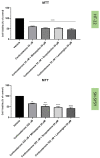Serotonin Type 3 Receptor Is Potentially Involved in Cellular Stress Induced by Hydrogen Peroxide
- PMID: 36295079
- PMCID: PMC9605598
- DOI: 10.3390/life12101645
Serotonin Type 3 Receptor Is Potentially Involved in Cellular Stress Induced by Hydrogen Peroxide
Abstract
Depression is a disease with several molecular mechanisms involved, such as problems in the serotonergic pathway. This disease is very complex and prevalent, and thus important to deeply study and aim to overcome high rates of relapse and therapeutic failure. In this study, two cellular lines were used (HT-22 and SH-SY5Y cells) to gain insight about the role of the serotonin type 3 (5-HT3) receptor in cellular stress induced by hydrogen peroxide and/or corticosterone. In research, these compounds are known to mimic the high levels of oxidative stress and dysfunction of the hypothalamus-hypophysis-adrenal axis by the action of glucocorticoids, usually present in depressed individuals. The receptor 5-HT3 is also known to be involved in depression, previously demonstrated in studies that highlight the role of these receptors as promising targets for antidepressant therapy. Indeed, the drugs used in this work (mirtazapine, scopolamine, and lamotrigine) interact with this serotonergic receptor. Thus, by using cell morphology, cell viability (neutral red and MTT), and HPLC assays, this work aimed to understand the role of these drugs in the stress induced by H2O2/corticosterone to HT-22 and SH-SY5Y cell lines. We concluded that the antagonism of the 5-HT3 receptor by these drugs may be important in the attenuation of H2O2-induced oxidative stress to the cells, but not in the corticosterone-induced stress.
Keywords: 5-HT3 receptor; corticosterone; hydrogen peroxide; lamotrigine; mirtazapine; scopolamine; serotonin.
Conflict of interest statement
The authors declare no conflict of interest.
Figures















Similar articles
-
The Effect of the Stress Induced by Hydrogen Peroxide and Corticosterone on Tryptophan Metabolism, Using Human Neuroblastoma Cell Line (SH-SY5Y).Int J Mol Sci. 2023 Feb 23;24(5):4389. doi: 10.3390/ijms24054389. Int J Mol Sci. 2023. PMID: 36901819 Free PMC article.
-
Cell Model of Depression: Reduction of Cell Stress with Mirtazapine.Int J Mol Sci. 2022 Apr 29;23(9):4942. doi: 10.3390/ijms23094942. Int J Mol Sci. 2022. PMID: 35563333 Free PMC article.
-
Mirtazapine : A Review of its Pharmacology and Therapeutic Potential in the Management of Major Depression.CNS Drugs. 1996 May;5(5):389-402. doi: 10.2165/00023210-199605050-00007. CNS Drugs. 1996. PMID: 26071050
-
Studies on the neuroendocrine role of serotonin.Dan Med Bull. 2007 Nov;54(4):266-88. Dan Med Bull. 2007. PMID: 18208678 Review.
-
Review of the results from clinical studies on the efficacy, safety and tolerability of mirtazapine for the treatment of patients with major depression.J Affect Disord. 1998 Dec;51(3):267-85. doi: 10.1016/s0165-0327(98)00224-9. J Affect Disord. 1998. PMID: 10333982 Review.
Cited by
-
Repurposed Antipsychotics as Potential Anticancer Agents: Clozapine Efficacy and Dopaminergic Pathways in Neuroblastoma and Glioblastoma.Life (Basel). 2025 Jul 12;15(7):1097. doi: 10.3390/life15071097. Life (Basel). 2025. PMID: 40724598 Free PMC article.
-
Exploring the Role of Drug Repurposing in Bridging the Hypoxia-Depression Connection.Membranes (Basel). 2023 Sep 17;13(9):800. doi: 10.3390/membranes13090800. Membranes (Basel). 2023. PMID: 37755222 Free PMC article.
-
Missing Puzzle Pieces in Dementia Research: HCN Channels and Theta Oscillations.Aging Dis. 2024 Feb 1;15(1):22-42. doi: 10.14336/AD.2023.0607. Aging Dis. 2024. PMID: 37450922 Free PMC article. Review.
-
Nanovesicular Mediation of the Gut-Brain Axis by Probiotics: Insights into Irritable Bowel Syndrome.Biology (Basel). 2024 Apr 25;13(5):296. doi: 10.3390/biology13050296. Biology (Basel). 2024. PMID: 38785778 Free PMC article.
-
5-HT3 Receptors on Mitochondria Influence Mitochondrial Function.Int J Mol Sci. 2023 May 5;24(9):8301. doi: 10.3390/ijms24098301. Int J Mol Sci. 2023. PMID: 37176009 Free PMC article.
References
-
- Depressão|SNS24. [(accessed on 13 September 2022)]; Available online: https://www.sns24.gov.pt/tema/saude-mental/depressao/#sec-16.
-
- Nuggerud-Galeas S., Sáez-Benito Suescun L., Berenguer Torrijo N., Sáez-Benito Suescun A., Aguilar-Latorre A., Magallón Botaya R., Oliván Blázquez B. Analysis of depressive episodes, their recurrence and pharmacologic treatment in primary care patients: A retrospective descriptive study. PLoS ONE. 2020;15:e0233454. doi: 10.1371/journal.pone.0233454. - DOI - PMC - PubMed
-
- Jantas D. Herbal Medicine in Depression. Springer International Publishing; Cham, Switzerland: 2016. Cell-Based Systems of Depression: An Overview; pp. 75–117.
LinkOut - more resources
Full Text Sources

